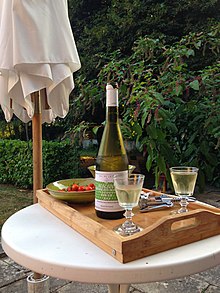
Muscadet (UK: /ˈmʌskədeɪ, ˈmʊsk-/ MU(U)SK-ə-day, US: /ˌmʌskəˈdeɪ, ˌmʊsk-/ MU(U)SK-ə-DAY, French: [myskadɛ] ) is a French white wine. It is made at the western end of the Loire Valley, near the city of Nantes in the Pays de la Loire region. It is made from the Melon de Bourgogne grape, often referred to simply as melon. While most appellation d'origine contrôlée wines are named after their growing region, or in Alsace after their variety, the name Muscadet refers to an alleged characteristic of the wine produced by the melon grape variety: vin qui a un goût musqué (wine with a musk-like taste). However, according to wine expert Tom Stevenson, Muscadet wines do not have much, if any, muskiness or Muscat-like flavors or aromas.[1]
The sole variety used to produce Muscadet, Melon de Bourgogne, was initially planted in the region sometime in or before the 17th century. It became dominant after a hard freeze in 1709 killed most of the region's vines. Dutch traders, who were major actors in the French wine trade, encouraged the planting of this variety; they distilled much of the wine produced into eau de vie for sale in Northern Europe.[2]
The generic Muscadet appellation, officially established in 1937, contains three regional sub-appellations:
- Muscadet-Sèvre et Maine, officially established in 1936, covering 20,305 acres (8,217 hectares) with 21 villages in the Loire-Atlantique department and 2 in the Maine-et-Loire department. This appellation produces 80% of all Muscadets.
- Muscadet-Coteaux de la Loire, officially established in 1936, covering 467 acres (189 hectares) with 24 villages spread across the Loire-Atlantique and Maine-et-Loire departments.
- Muscadet-Côtes de Grandlieu, officially established in 1994, benefits from the Grandlieu lake's microclimate. This sub appellation covers 717 hectares with 17 villages in the Loire-Atlantique department and 2 villages in the Vendée department.[3]
- ^ Stevenson, Tom (2005). The Sotheby's Wine Encyclopedia. London & New York: Dorling Kindersley. pp. 200–01. ISBN 0-7566-1324-8.
- ^ Johnson, Hugh (1989). Vintage: The Story of Wine. New York: Simon and Schuster. pp. 175–80. ISBN 0-671-68702-6.
- ^ "INAO - Institut National de l'Origine et de la qualité" (PDF). INAO. [dead link]